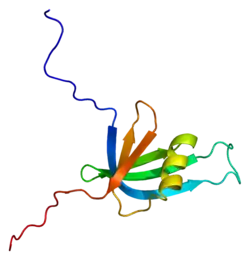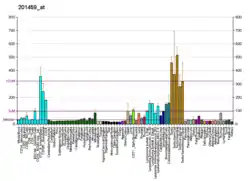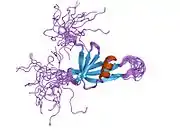RUVBL2
RuvB-like 2 (E. coli), also known as RUVBL2, is a human gene coding for a protein belonging to the AAA+ family of proteins.
Function
This gene encodes the second human homologue of the bacterial RuvB gene. Bacterial RuvB protein is a DNA helicase essential for homologous recombination and DNA double-strand break repair. However, the evidence for whether RUVBL2 has DNA helicase activity is contradictory.[5] This gene is physically linked to the CGB/LHB gene cluster on chromosome 19q13.3, and is very close (55 nt) to the LHB gene, in the opposite orientation.[6]
Interactions
RUVBL2 has been shown to interact with RuvB-like 1[7] and Activating transcription factor 2.[8]
References
- GRCh38: Ensembl release 89: ENSG00000183207 - Ensembl, May 2017
- GRCm38: Ensembl release 89: ENSMUSG00000003868 - Ensembl, May 2017
- "Human PubMed Reference:". National Center for Biotechnology Information, U.S. National Library of Medicine.
- "Mouse PubMed Reference:". National Center for Biotechnology Information, U.S. National Library of Medicine.
- Puri T, Wendler P, Sigala B, Saibil H, Tsaneva IR (Feb 2007). "Dodecameric structure and ATPase activity of the human TIP48/TIP49 complex". Journal of Molecular Biology. 366 (1): 179–92. doi:10.1016/j.jmb.2006.11.030. PMID 17157868.
- "Entrez Gene: RUVBL2 RuvB-like 2 (E. coli)".
- Ewing RM, Chu P, Elisma F, Li H, Taylor P, Climie S, McBroom-Cerajewski L, Robinson MD, O'Connor L, Li M, Taylor R, Dharsee M, Ho Y, Heilbut A, Moore L, Zhang S, Ornatsky O, Bukhman YV, Ethier M, Sheng Y, Vasilescu J, Abu-Farha M, Lambert JP, Duewel HS, Stewart II, Kuehl B, Hogue K, Colwill K, Gladwish K, Muskat B, Kinach R, Adams SL, Moran MF, Morin GB, Topaloglou T, Figeys D (2007). "Large-scale mapping of human protein-protein interactions by mass spectrometry". Molecular Systems Biology. 3 (1): 89. doi:10.1038/msb4100134. PMC 1847948. PMID 17353931.
- Cho SG, Bhoumik A, Broday L, Ivanov V, Rosenstein B, Ronai Z (Dec 2001). "TIP49b, a regulator of activating transcription factor 2 response to stress and DNA damage". Molecular and Cellular Biology. 21 (24): 8398–413. doi:10.1128/MCB.21.24.8398-8413.2001. PMC 100004. PMID 11713276.
Further reading
- Doyon Y, Côté J (Apr 2004). "The highly conserved and multifunctional NuA4 HAT complex". Current Opinion in Genetics & Development. 14 (2): 147–54. doi:10.1016/j.gde.2004.02.009. PMID 15196461.
- Kanemaki M, Kurokawa Y, Matsu-ura T, Makino Y, Masani A, Okazaki K, Morishita T, Tamura TA (Aug 1999). "TIP49b, a new RuvB-like DNA helicase, is included in a complex together with another RuvB-like DNA helicase, TIP49a". The Journal of Biological Chemistry. 274 (32): 22437–44. doi:10.1074/jbc.274.32.22437. PMID 10428817.
- Salzer U, Kubicek M, Prohaska R (Sep 1999). "Isolation, molecular characterization, and tissue-specific expression of ECP-51 and ECP-54 (TIP49), two homologous, interacting erythroid cytosolic proteins". Biochimica et Biophysica Acta (BBA) - Gene Structure and Expression. 1446 (3): 365–70. doi:10.1016/S0167-4781(99)00104-9. PMID 10524211.
- Lai CH, Chou CY, Ch'ang LY, Liu CS, Lin W (May 2000). "Identification of novel human genes evolutionarily conserved in Caenorhabditis elegans by comparative proteomics". Genome Research. 10 (5): 703–13. doi:10.1101/gr.10.5.703. PMC 310876. PMID 10810093.
- Wood MA, McMahon SB, Cole MD (Feb 2000). "An ATPase/helicase complex is an essential cofactor for oncogenic transformation by c-Myc". Molecular Cell. 5 (2): 321–30. doi:10.1016/S1097-2765(00)80427-X. PMID 10882073.
- Ikura T, Ogryzko VV, Grigoriev M, Groisman R, Wang J, Horikoshi M, Scully R, Qin J, Nakatani Y (Aug 2000). "Involvement of the TIP60 histone acetylase complex in DNA repair and apoptosis". Cell. 102 (4): 463–73. doi:10.1016/S0092-8674(00)00051-9. PMID 10966108. S2CID 18047169.
- Parfait B, Giovangrandi Y, Asheuer M, Laurendeau I, Olivi M, Vodovar N, Vidaud D, Vidaud M, Bièche I (2000). "Human TIP49b/RUVBL2 gene: genomic structure, expression pattern, physical link to the human CGB/LHB gene cluster on chromosome 19q13.3". Annales de Génétique. 43 (2): 69–74. doi:10.1016/S0003-3995(00)01016-9. PMID 10998447.
- Hartley JL, Temple GF, Brasch MA (Nov 2000). "DNA cloning using in vitro site-specific recombination". Genome Research. 10 (11): 1788–95. doi:10.1101/gr.143000. PMC 310948. PMID 11076863.
- Bauer A, Chauvet S, Huber O, Usseglio F, Rothbächer U, Aragnol D, Kemler R, Pradel J (Nov 2000). "Pontin52 and reptin52 function as antagonistic regulators of beta-catenin signalling activity". The EMBO Journal. 19 (22): 6121–30. doi:10.1093/emboj/19.22.6121. PMC 305835. PMID 11080158.
- Wiemann S, Weil B, Wellenreuther R, Gassenhuber J, Glassl S, Ansorge W, Böcher M, Blöcker H, Bauersachs S, Blum H, Lauber J, Düsterhöft A, Beyer A, Köhrer K, Strack N, Mewes HW, Ottenwälder B, Obermaier B, Tampe J, Heubner D, Wambutt R, Korn B, Klein M, Poustka A (Mar 2001). "Toward a catalog of human genes and proteins: sequencing and analysis of 500 novel complete protein coding human cDNAs". Genome Research. 11 (3): 422–35. doi:10.1101/gr.GR1547R. PMC 311072. PMID 11230166.
- Simpson JC, Wellenreuther R, Poustka A, Pepperkok R, Wiemann S (Sep 2000). "Systematic subcellular localization of novel proteins identified by large-scale cDNA sequencing". EMBO Reports. 1 (3): 287–92. doi:10.1093/embo-reports/kvd058. PMC 1083732. PMID 11256614.
- Cho SG, Bhoumik A, Broday L, Ivanov V, Rosenstein B, Ronai Z (Dec 2001). "TIP49b, a regulator of activating transcription factor 2 response to stress and DNA damage". Molecular and Cellular Biology. 21 (24): 8398–413. doi:10.1128/MCB.21.24.8398-8413.2001. PMC 100004. PMID 11713276.
- Park J, Wood MA, Cole MD (Mar 2002). "BAF53 forms distinct nuclear complexes and functions as a critical c-Myc-interacting nuclear cofactor for oncogenic transformation". Molecular and Cellular Biology. 22 (5): 1307–16. doi:10.1128/MCB.22.5.1307-1316.2002. PMC 134713. PMID 11839798.
- Ohta S, Shiomi Y, Sugimoto K, Obuse C, Tsurimoto T (Oct 2002). "A proteomics approach to identify proliferating cell nuclear antigen (PCNA)-binding proteins in human cell lysates. Identification of the human CHL12/RFCs2-5 complex as a novel PCNA-binding protein". The Journal of Biological Chemistry. 277 (43): 40362–7. doi:10.1074/jbc.M206194200. PMID 12171929.
- Watkins NJ, Dickmanns A, Lührmann R (Dec 2002). "Conserved stem II of the box C/D motif is essential for nucleolar localization and is required, along with the 15.5K protein, for the hierarchical assembly of the box C/D snoRNP" (PDF). Molecular and Cellular Biology. 22 (23): 8342–52. doi:10.1128/MCB.22.23.8342-8352.2002. PMC 134055. PMID 12417735.
- Gevaert K, Goethals M, Martens L, Van Damme J, Staes A, Thomas GR, Vandekerckhove J (May 2003). "Exploring proteomes and analyzing protein processing by mass spectrometric identification of sorted N-terminal peptides". Nature Biotechnology. 21 (5): 566–9. doi:10.1038/nbt810. PMID 12665801. S2CID 23783563.
- Cai Y, Jin J, Tomomori-Sato C, Sato S, Sorokina I, Parmely TJ, Conaway RC, Conaway JW (Oct 2003). "Identification of new subunits of the multiprotein mammalian TRRAP/TIP60-containing histone acetyltransferase complex". The Journal of Biological Chemistry. 278 (44): 42733–6. doi:10.1074/jbc.C300389200. PMID 12963728.
- Gstaiger M, Luke B, Hess D, Oakeley EJ, Wirbelauer C, Blondel M, Vigneron M, Peter M, Krek W (Nov 2003). "Control of nutrient-sensitive transcription programs by the unconventional prefoldin URI". Science. 302 (5648): 1208–12. doi:10.1126/science.1088401. PMID 14615539. S2CID 26836888.
This article is issued from Wikipedia. The text is licensed under Creative Commons - Attribution - Sharealike. Additional terms may apply for the media files.






